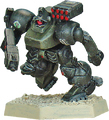Chameleon
The Chameleon was developed in the aftermath of the War of the Alliance as part of the Southern push to bridge the technological gap opened up by the North in the previous decade. During the conflict, Southern commanders saw Northern stealth Gears like the Black Cat and the then-experimental Panther in action. Although they were happy to have the stealth units deployed during the war, Republican leaders understood that they could just as easily be turned against them and were determined to match the North Gear for Gear.
Territorial Arms Skunk Works was contracted to produce two stealth Gears in the TN 1920s and the Chameleon was the first to reach the battlefield. The Snakeye Black Mamba would soon follow.
As its name indicates, the Chameleon is a unit designed especially to “disappear,” blending in with its surroundings. At first glance, the Chameleon looks simply like a modified Iguana with slightly more blocky armor plates. This impression soon vanishes when the advanced electronic modules and the interior of the machine’s cockpit are examined. While the Territorial Arms Iguana did provide the basic model for the Chameleon, very few, if any, components remain the same. The Gear’s instrumentation has been updated to the next generation of Virtual Reality Heads Up Display (VRHUD) system, and the Skunk Works reportedly commissioned a low-emission version of the Obelisk Electronics MERIT sensor and communications suite designed for the Iguana, but the details of its manufacture and capabilities remain classified.
Just like its larger brother, the Snakeye BM, the Chameleon is powered by a gas turbine engine linked to an electric generator and a super-conducting battery. This system enables the pilot to switch from turbine to battery when passing from standard to silent — or “whisper” — mode. The machine’s skin is covered with a black, rubber-like polymer glazing that absorbs both sound and light. The Chameleon’s weapons are specially modified stealth versions of the standard Iguana weapons payload, consisting of a TASW-15 pack gun and a Vogel-6 STL rocket pod.
Usage
The Chameleon was the logical answer to the Black Cat scout used by the Northern military as an infiltration unit during the War of the Alliance. Like the Cat, the Chameleon has never been produced in large numbers and almost all of the Gears are in the hands of elite units such as the Légion Noire and the Southern Republic Intelligence Directorate’s infiltration and black operations squads. The details of the Chameleon's deployment and activities remain well-kept military secrets, but most analysts feel that it has had very little “down time” since its delivery to the Légion in TN 1924. The Légion uses the stealth Gear as part of dedicated infiltration and covert operations cadres, usually in conjunction with Green Mambas or Snakeye Black Mambas and most of the top Gear regiments of the Légion are known to have one of these cadres ready for action. In TN 1931, Territorial Arms imposed a very tight security cordon on one of its Timbuktu production lines and most observers believe that a good number of stealth Gears were produced under the cover of air-tight secrecy.
These rumors seem to be corroborated by a slightly wider distribution of stealth units. Republican and a few MILICIA regiments have begun to receive a single Chameleon to use in solitary infiltration missions. Some critics have questioned the value of disseminating high-technology stealth vehicles to standard units where they may not be used to their full effectiveness. Others have wondered aloud if the more lax security prevalent in MILICIA bases might threaten the secrecy that surrounds Southern stealth units.
These fears are known to have come true at least once, when a newly delivered Chameleon disappeared from a MILICIA base on the Badlands border of the Mekong Dominion in late TN 1932. An extensive investigation by MILICIA military police revealed that one of the conscripts in the base’s vehicle pool had contacts with an arms merchant tied to the Mongol bandits and had stolen the Gear for him. A strike was launched which utterly destroyed the merchant’s operation, but the missing Chameleon was never recovered. Some MPs familiar with the case have whispered that the whole operation may have been some sort of elaborate coverup. If so, it remains unclear just who stole the Gear and who had the power to deflect the investigation.
Gallery
| Units | |||||||||||||||||||||||||||||||||||||||||||||||||||||||||||||
|---|---|---|---|---|---|---|---|---|---|---|---|---|---|---|---|---|---|---|---|---|---|---|---|---|---|---|---|---|---|---|---|---|---|---|---|---|---|---|---|---|---|---|---|---|---|---|---|---|---|---|---|---|---|---|---|---|---|---|---|---|---|
| Terra Nova |
| ||||||||||||||||||||||||||||||||||||||||||||||||||||||||||||
| Earth |
| ||||||||||||||||||||||||||||||||||||||||||||||||||||||||||||
| Caprice |
| ||||||||||||||||||||||||||||||||||||||||||||||||||||||||||||
| Utopia |
| ||||||||||||||||||||||||||||||||||||||||||||||||||||||||||||
| Eden |
| ||||||||||||||||||||||||||||||||||||||||||||||||||||||||||||

